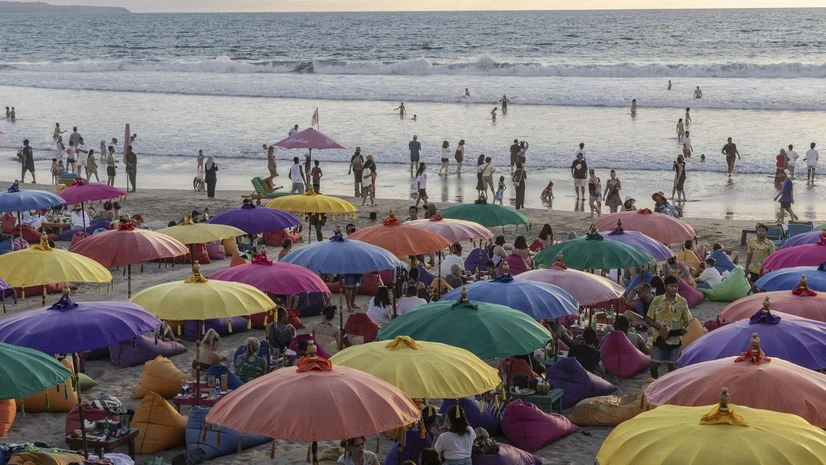By Karishma Vaswani
Bali is broken. These days, the jewel in Indonesia’s crown of sun-kissed islands is less paradise, more parking lot. Tourists are bringing in much-desired revenue, but there’s just too many of them. The government’s proposal to temporarily curb new building construction of hotels and villas can’t come quickly enough.
The “Island of the Gods” needs urgent attention. It’s the archipelago’s golden goose, accounting for a significant chunk of international arrivals, bringing in visitors from all over the world. Authorities need to come up with a solution to mange the rampant overdevelopment that’s become Bali’s hallmark, keep the number of visitors under control and protect the local environment and culture.
Indonesia is home to 18,000 islands, but only 6,000 are inhabited. Of these, Bali has historically enjoyed pole position in the rankings of most-popular holiday spot. It sits to the east of the country’s most populous island of Java, separated by the narrow Bali Strait. The majority-Hindu population is also a draw, offering starkly different culture and customs (Indonesia is the world’s largest Muslim nation.)
)
)
It was also among the hardest-hit regions when Covid-19 struck, leaving hotels and beaches empty. Tourists contribute more than 60 per cent to the island’s economy, providing much-needed employment for its more than 4 million inhabitants.
So when they disappeared, gross domestic product shrank by 9.3 per cent in 2020, the worst among all of Indonesia’s provinces. I traveled to Bali soon after borders opened and saw the extent of the damage first-hand. So many friends and contacts in the local tourism industry had lost jobs, forced to return to their family’s farmlands to make ends meet.
More From This Section
Since then though, visitors have come back — and with a vengeance. Around 5 million visitors arrived in 2023 — close to 2019 levels, a number that’s expected to grow even further this year. Much of this is down to the success of various government initiatives — incentives like the “second home” and golden visas for wealthy global citizens and foreign investors, and the digital nomad programs popular with the crypto-currency trading crowd.
Turns out you can have too much of a good thing. An enclave for hippies in the 1970s, and a rite of passage for surfers looking for the perfect wave, so many of those picture-perfect Balinese destinations — Uluwatu, Padang-Padang and especially Canggu — have morphed from heavenly beach spots into nightmarish neighborhoods. Snaking, hours-long traffic jams and noisy construction are the norm and not the exception. Hardly the peaceful getaway to escape city life.
)
Turns out you can have too much of a good thing. An enclave for hippies in the 1970s, and a rite of passage for surfers looking for the perfect wave, so many of those picture-perfect Balinese destinations — Uluwatu, Padang-Padang and especially Canggu — have morphed from heavenly beach spots into nightmarish neighborhoods. Snaking, hours-long traffic jams and noisy construction are the norm and not the exception. Hardly the peaceful getaway to escape city life.
)
That’s why the provincial government is considering curbing the construction of new hotels, villas, discos and beach clubs. It’s aimed at slowing down the pace of land development and overcrowding in tourist hot spots. You just need to take a drive to one of the busy districts like Seminyak to see the number of villas and hotels being built. Concrete and cement structures now stand in the place of lush green paddy fields. To help fund ecological protection projects, authorities launched a $10 tourist tax, but it has had little to no success because of poor implementation. Most tourists don’t even know they have to pay it.
Not all visitors are welcome. Officials have talked about how badly behaved some are, and the risk to local culture. Holiday-makers posing naked on sacred mountains, allegations of drug abuse, and attacks on local people have exhausted patience. The government deported more than 100 tourists last year, and imposed a motorbike ban after a spate of dangerous road accidents.
Previous administrations have tried to solve these problems before, but nothing has worked, mainly because of a lack of policy implementation. Even with this plan to temporarily halt development, which sounds great on paper, there is no clear timeline.
There are concrete things Indonesian authorities can do. A railway transport plan, connecting the airport with popular tourist hubs, would go a long way to solve the gridlock issue. But many Balinese say they don’t see it benefiting them, and the construction will no doubt add to the current traffic. A completion date of 2027 is being discussed, but even before the project has kicked off properly there are concerns about an over-reliance on Chinese contractors, and the possibility that it could be held up by local regulations.
It’s time to look beyond Bali, and diversify Indonesia’s holiday destination offerings. Other islands, like Sumba and Labuan Bajo, are starting to become popular with discerning tourists, though none has Bali’s the mass appeal. Improving air connectivity and infrastructure, and marketing them better, would go a long way toward attracting more visitors. This would help to reduce the dependence on Bali as a cash-cow, and also add to Indonesia’s appeal as a vacation spot.
Spanning the distance between London and Baghdad from west to east, with three different time zones and hundreds of different ethnic groups and languages, Indonesia is a big and beautiful country. The next Bali is just waiting to be found. The gods of the island will thank you for it.
Disclaimer: This is a Bloomberg Opinion piece, and these are the personal opinions of the writer. They do not reflect the views of www.business-standard.com or the Business Standard newspaper

)